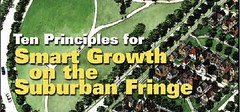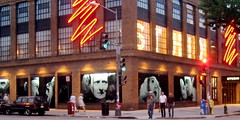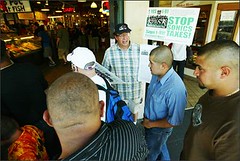Incredulities of the week
(Maybe I'll have to consider this as a weekly feature for weekend blogging.)
1. The Urban Land Institute published a report in their "Ten Principles" series, Ten Principles for Smart Growth on the Suburban Fringe. (Published in 2004, I just came across it.)
 Stupid Growth or Smart Growth? Extract from the report cover.
Stupid Growth or Smart Growth? Extract from the report cover.By definition, on the suburban fringe, development isn't "smart."
By definition, "sustainable land use and resource planning" would direct growth to areas with extant infrastructure, including adequate roads and transportation assets, as well as infill and redevelopment opportunities.
This is but one more example of why I don't use the phrase "smart growth," even though there are good examples of it (development in Arlington County along the Wilson Blvd. corridor, Bethesda Row in downtown Bethesda, revitalization and redevelopment along 14th Street NW, sparked in large part by the efforts of Abdo Development, and the long ago early entry of the Studio Theater).
 Flickr photo of Studio Theater, at 14th and P Streets NW, Washington, DC, by Eye Captain.
Flickr photo of Studio Theater, at 14th and P Streets NW, Washington, DC, by Eye Captain.But without strong definition of what "smart growth" is and isn't, and where growth is smart and where it isn't, as a useful term and as a signifier of quality and soundness, smart growth becomes meaningless.
For example, is it "smart growth" to move around military functions to different places where yes, there are extant facilities, but where the new development will increase demands for water beyond what the area can provide without resorting to the construction of a desalination plant, or where the area possesses little in the way of transportation infrastructure other than roads for automobiles? (Also see this editorial from the Examiner, "Gridlock coming to Fort Belvoir," as well as previous blog entries.)
2. Instead of dealing with how sports teams and leagues extract concessions and money from various localities (at the municipal, county, and state level) to the tune of billions of dollars, Congress is calling on the Federal Communications Commission to get involved in the business dispute between Comcast Corporation and the Baltimore Orioles baseball team, over local broadcast of Washington Nationals baseball games.
Congress didn't seem too interested before, when Major League Baseball forced the Washington Nationals into a joint broadcast venture with the Baltimore Orioles in a manner that favored the Orioles in terms of control and profits. This was done to keep the owner of the Orioles happy and out of the courtroom--another negative consequence of Major League Baseball's exemption from antitrust laws.
See "Congressmen ask FCC for action on Nationals games," from the Examiner.
 See "Battling another stadium subsidy: Man who led fight against Qwest Field, Safeco aims at Sonics," from the Seattle Post-Intelligencer. Photo Caption: Paul Joseph Brown /Seattle Post-Intelligencer. Chris Van Dyk, leader of Citizens for More Important Things, campaigns at Pike Place Market against the Sonics' bid for a tax-subsidized KeyArena overhaul.
See "Battling another stadium subsidy: Man who led fight against Qwest Field, Safeco aims at Sonics," from the Seattle Post-Intelligencer. Photo Caption: Paul Joseph Brown /Seattle Post-Intelligencer. Chris Van Dyk, leader of Citizens for More Important Things, campaigns at Pike Place Market against the Sonics' bid for a tax-subsidized KeyArena overhaul.3. Why can't the Washington Post, for once, editorialize in favor of quality in the built environment, instead of always bending over to kiss the "behind" of the Growth Machine, in this case the Lerners--who must be angry that another member of the Growth Machine, Herb Miller, is getting a chance to make some money from ancillary development around the stadium, instead of them.
The parking lot and freeway surrounded Turner Field is the one stadium complex built by Stan Kasten, president of the Washington Nationals. It is not an urban design-appropriate model. Nor are any of the shopping center developments construted by Lerner Enterprises in the Washington suburbs.
 Image of Turner Field, Atlanta, from www.ballparks.com.
Image of Turner Field, Atlanta, from www.ballparks.com.For the second time in a couple of weeks, the Washington Post has editorialized in favor of building surface parking lots for the Washington Nationals, which is not allowed by the Zoning Regulations, and more importantly, is ugly and antithetical to the principles of urban design, not to mention a serious drawback in terms of truly realizing positive spillover benefits from the hundreds of millions of dollars that the District of Columbia citizens are "investing" in the team through tax dollars spent to build the stadium and the related infrastructure improvements, in addition to the losses that the District of Columbia residents are sustaining in terms of the displaced organizations such as the Washington Sculpture Center and the Washington Glass School.
See "Parking at the Ballpark : A dose of realism on the stadium project", from the Saturday Post.
The Washington Post editorial page, on these kinds of issues, isn't much different than that of the Wall Street Journal, which editorialized recently that the New York Times is treasonous for publishing stories about the U.S. Government's monitoring of international financial transactions, in search of terrorist activity. As a WSJ reporter said, "I don't know any reporter for the Wall Street Journal who believes that about the New York Times." The WSJ editorial page is known for its hardline approach and stalwart support of conservative politics and politicians.
Granted I am sure that most reporters on the Post staff don't care that much about urban design (I know that Ben Forgey, the architecture critic, doesn't seem to pay it much attention). Still, I wish that the Post would "step up and represent" on this issue, instead of acquiesce.
If they would, it would strengthen the city's hand, instead of completely weakening it. As it is, the Zoning Commission appears willing to go along on an underground-aboveground parking scheme, when the law requires underground parking. Isn't that enough acquiescence?
 Politicians and newspapers plant one on the Growth Machine. Image from Fast Blogit.
Politicians and newspapers plant one on the Growth Machine. Image from Fast Blogit.The Post editorials on this matter remind me of how the residents of Poletown in Detroit were sold out by the Catholic Church. Had the Archdiocese not agreed to sell their churches to the City of Detroit, the parallel eminent domain action to level the neighborhood in favor of a to be constructed auto manufacturing plant would have had difficulties moving forward. Instead, the Church undercut the ability of the residents to fight, and the Poletown GM plant ended up being constructed. Yet today, not only is the neighborhood gone, but the plant has been closed for many years as well, another victim of GM's inability to focus on designing and manufacturing cars that customers want to buy.
Also see this blog entry from a few weeks ago, The Washington Post editorial page caves in to the Growth Machine, which discussed June's pro-parking lots editorial, among others.
Index Keywords: urban-revitalization; stadiums-arenas



0 Comments:
Post a Comment
<< Home